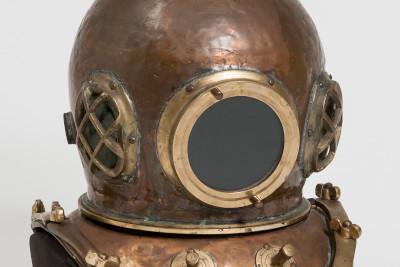Diving Helmet
Production date
1944
Country
USA
See full details
Object detail
Description
U.S.Navy Mk V Mod 1 Diving Helmet, 1944 (USA)
12 bolt, 4 light (window). Standard United States Navy dress diving helmet. Manufactured by the DESCO (Diving Equipment & Salvage Company).
12 bolt, 4 light (window). Standard United States Navy dress diving helmet. Manufactured by the DESCO (Diving Equipment & Salvage Company).
Classification
MARITIME TECHNOLOGY Diving Diver's helmet
Production date
1944
Production place
Measurements
H520mm x W360mm x D440mm
Media/Materials description
Brass, copper alloy, rubber, glass
Signature/Marks
Manufacturer's name plaque (centre front of corselet)
U.S. NAVY DIVING HELMET
MARK V - MOD. 1
DIVING EQUIPMENT AND SALVAGE CO. INC.
MILWAUKEE, WIS.
NO. 820
DATE 1 4 44
'FRONT' is stamped on the front centre, left and right, brails.
'BACK' is stamped on the back centre, left and right, brails.
U.S. NAVY DIVING HELMET
MARK V - MOD. 1
DIVING EQUIPMENT AND SALVAGE CO. INC.
MILWAUKEE, WIS.
NO. 820
DATE 1 4 44
'FRONT' is stamped on the front centre, left and right, brails.
'BACK' is stamped on the back centre, left and right, brails.
History and use
Used by the US Navy between 1916 and 1984, the Mark V is one of the most recognisable helmets. The manufacture of these helmets was contracted out to four different companies and constructed within the specifications provided by the US Navy.
Unlike other helmets, the air outlet on the Mk V has an exhaust tube extending under and behind the right side light (window) called a 'banana exhaust' (because of its shape). The exhaust can be activated from inside by the diver with his chin.
Due to its robust construction, 3 lights (windows) protected by grills and a hinged front light (window), these helmets were used by salvage divers in Australia after WWII.
Legendary Queensland diver, Neil 'hot Toddy' Todkill used the Mark V for numerous salvage jobs and waterfront work from the 1940-1960s.
DESCO began in 1937 as a Wisconsin corporation under the name: Diving Equipment and Salvage Company. Messer's Browne, Nohl and End (Dr.) worked together to design a new type of lightweight, self-contained diving suit. WWII brought large Navy contracts for diving equipment to DESCO. After the Korean War, which again increased US Navy contracts and orders, the company changed hands several times.
In 1960, Max Nohl and his wife were tragically killed in an automobile accident. In May 1966, Tom and Marilyn Fifield purchased DESCO, moving it to its present location at 240 North Milwaukee Street, Milwaukee. Mr Fifield was responsible in the 1960s, for the design and development of the DESCO diving helmet, which remains a standard piece of modern equipment for diving with air in relatively shallow water where mixed gases are not needed.
Unlike other helmets, the air outlet on the Mk V has an exhaust tube extending under and behind the right side light (window) called a 'banana exhaust' (because of its shape). The exhaust can be activated from inside by the diver with his chin.
Due to its robust construction, 3 lights (windows) protected by grills and a hinged front light (window), these helmets were used by salvage divers in Australia after WWII.
Legendary Queensland diver, Neil 'hot Toddy' Todkill used the Mark V for numerous salvage jobs and waterfront work from the 1940-1960s.
DESCO began in 1937 as a Wisconsin corporation under the name: Diving Equipment and Salvage Company. Messer's Browne, Nohl and End (Dr.) worked together to design a new type of lightweight, self-contained diving suit. WWII brought large Navy contracts for diving equipment to DESCO. After the Korean War, which again increased US Navy contracts and orders, the company changed hands several times.
In 1960, Max Nohl and his wife were tragically killed in an automobile accident. In May 1966, Tom and Marilyn Fifield purchased DESCO, moving it to its present location at 240 North Milwaukee Street, Milwaukee. Mr Fifield was responsible in the 1960s, for the design and development of the DESCO diving helmet, which remains a standard piece of modern equipment for diving with air in relatively shallow water where mixed gases are not needed.
Associated person
Registration number
H3878




